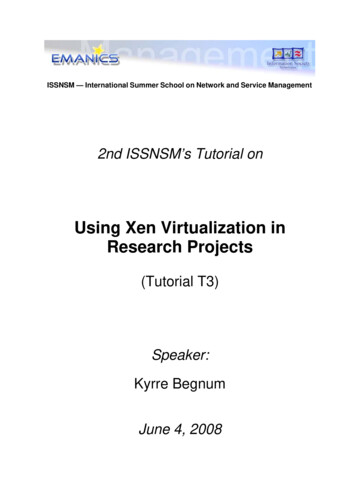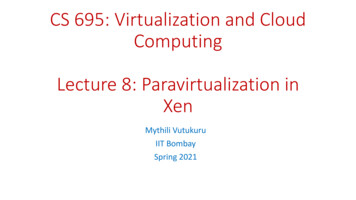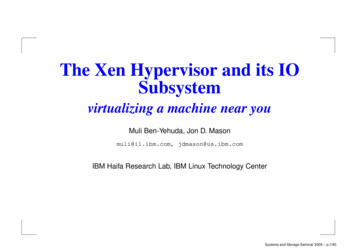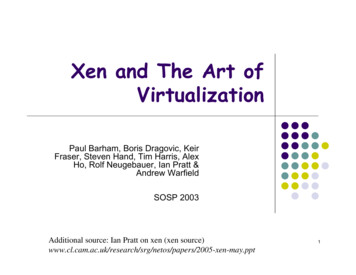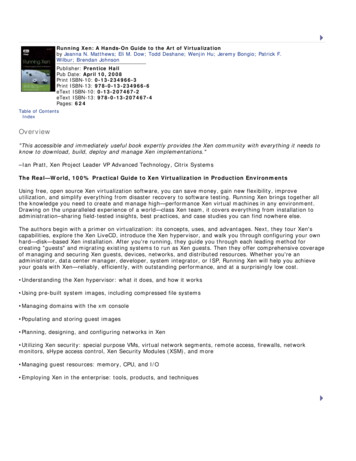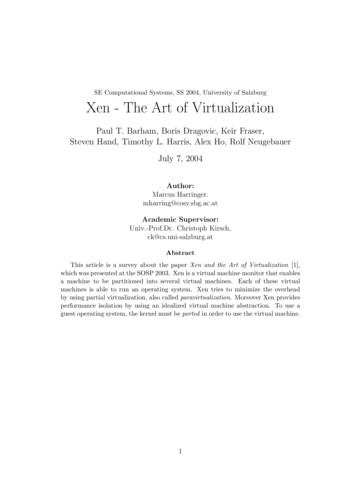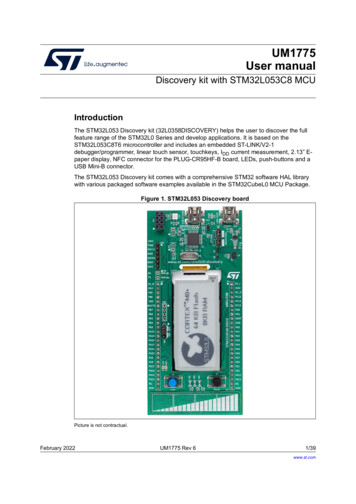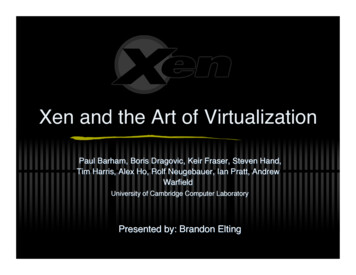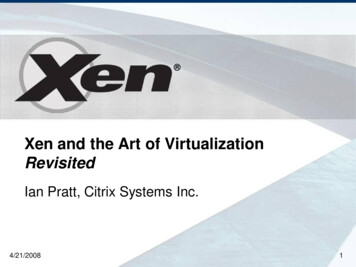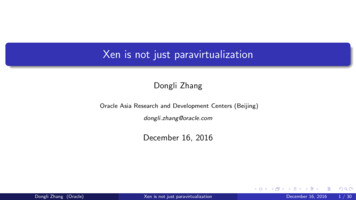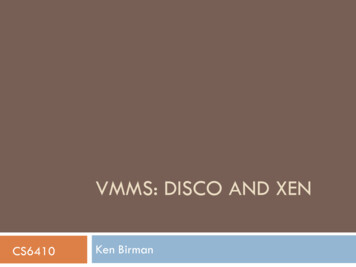
Transcription
VMMS: DISCO AND XENCS6410Ken Birman
Disco (First version of VMWare)Edouard Bugnion, Scott Devine, and MendelRosenblum
Virtualization3 “a technique for hiding the physical characteristics ofcomputing resources from the way in which othersystems, applications, or end users interact with thoseresources. This includes making a single physicalresource appear to function as multiple logicalresources; or it can include making multiple physicalresources appear as a single logical resource”
Old idea from the 1960s4 IBM VM/370 – A VMM for IBM mainframe Multiple OS environments on expensive hardwareDesirable when few machine aroundPopular research idea in 1960s and 1970s Entire conferences on virtual machine monitorsHardware/VMM/OS designed together Interest died out in the 1980s and 1990s Hardware got more cheaperOperating systems got more powerful (e.g. multi-user)
A Return to Virtual Machines5 Disco: Stanford research project (SOSP ’97) Commercial virtual machines for x86 architecture VMware Workstation (now EMC) (1999-)Connectix VirtualPC (now Microsoft)Research virtual machines for x86 architecture Run commodity OSes on scalable multiprocessorsFocus on high-end: NUMA, MIPS, IRIXXen (SOSP ’03)plex86OS-level virtualization FreeBSD Jails, User-mode-linux, UMLinux
Overview6 Virtual Machine A fully protected and isolated copy of the underlyingphysical machine’s hardware. (definition by IBM)”Virtual Machine MonitorA thin layer of software that's between the hardware andthe Operating system, virtualizing and managing allhardware resources. Also known as “Hypervisor”
Classification of Virtual Machines7
Classification of Virtual Machines8 Type I VMM is implemented directly on the physical hardware.VMM performs the scheduling and allocation of theresources.IBM VM/370, Disco, VMware’s ESX Server, Xensystem’sType II VMMs are built completely on top of a host OS.The host OS provides resource allocation and standard executionenvironment to each “guest OS.”User-mode Linux (UML), UMLinux
Disco: Challenges Overheads Resource Management Additional ExecutionVirtualization I/OMemory management for multiple VMsLack of information to make good policy decisionsCommunication & Sharing Interface to share memory between multiple VMsBaseed on slides from 2011fa: Ashik R
Disco: Interface Processors – Virtual CPU Memory I/O Devices
Disco: Virtual CPUs Direct Execution on the real CPUIntercept Privileged InstructionsDifferent Modes: Kernel Mode: DiscoSupervisor Mode: Virtual MachinesUser Mode: rtualCPU
Disco: Memory Virtualization Adds a level of address translationUses Software reloaded TLB and pmapFlushes TLB on VCPU SwitchUses second level Software TLB
Disco: Memory Management Affinity SchedulingPage MigrationPage Replicationmemmap
Disco: I/O Virtualization Virtualizes access to I/O devices and intercepts all deviceaccessAdds device drivers in to OSSpecial support for Disk and Network access Copy-on-writeVirtual SubnetAllows memory sharing between VMs agnostic of each other
Running Commodity OSes Changes for MIPS Architecture Device Drivers Required to relocate the unmapped segmentAdded device drivers for I/O devices.Changes to the HAL Inserted some monitor calls in the OS
Experimental Results Uses Sim OS Simulator for Evaluations
Disco: Takeaways Develop system s/w with less effortLow/Modest overheadSimple solution for Scalable Hardware Subsequent history Rewritteninto VMWare, became a major product Performance hit a subject of much debate but successfuleven so, and of course evolved greatly Today a huge player in cloud market
XEN AND THE ART OFVIRTUALIZATIONPaul Barham, Boris Dragovic, Keir Fraser, Steven Hand,Tim Harris,Alex Ho, Rolf Neugebauery, Ian Pratt, Andrew Wareld
Xen’s Virtualization Goals IsolationSupport different Operating SystemsPerformance overhead should be small
Reasons to Virtualize Systems hosting multiple applications on a sharedmachineundergo the following problems:Do not support adequate isolationAffect of Memory Demand, Network Traffic,Scheduling Priority and Disk Access on process’sperformanceSystem Administration becomes Difficult
XEN : Introduction A Para-Virtualized InterfaceCan host Multiple and different Operating SystemsSupports IsolationPerformance Overhead is minimumCan Host up to 100 Virtual Machines
XEN : Approach Drawbacks of Full Virtualization with respect to x86 architecture Support for virtualization not inherent in x86 architectureCertain privileged instructions did not trap to the VMMVirtualizing the MMU efficiently was difficultOther than x86 architecture deficiencies, it is sometimes required to viewthe real and virtual resources from the guest OS point of viewXen’s Answer to the Full Virtualization problem: It presents a virtual machine abstraction that is similar but not identicalto the underlying hardware -para-virtualizationRequires Modifications to the Guest Operating SystemNo changes are required to the Application Binary Interface (ABI)
Terminology Used Guest Operating System (OS) – refers to one of theoperating systems that can be hosted by XEN.Domain – refers to a virtual machine within which aGuest OS runs and also an application orapplications.Hypervisor – XEN (VMM) itself.
XEN’s Virtual Machine Interface The virtual machine interface can be broadlyclassified into 3 parts. They are:Memory ManagementCPUDevice I/O
XEN’s VMI : Memory Management Problems Solutions x86 architecture uses a hardware managed TLBSegmentationOne way would be to have a tagged TLB, which is currently supported by someRISC architecturesGuest OS are held responsible for allocating and managing the hardware pagetables but under the control of HypervisorXEN should exist (64 MB) on top of every address spaceBenefits Safety and IsolationPerformance Overhead is minimized
XEN’s VMI : CPU Problems Inserting the Hypervisor below the Guest OS means that the Hypervisor will be the mostprivileged entity in the whole setupIf the Hypervisor is the most privileged entity then the Guest OS has to be modified toexecute in a lower privilege levelExceptionsSolutions x86 supports 4 distinct privilege levels – ringsRing 0 is the most and Ring 3 is the leastAllowing the guest OS to execute in ring 1- provides a way to catch theprivileged instructions of the guest OS at the HypervisorExceptions such as memory faults and software traps are solved by registering thehandlers with the HypervisorGuest OS must register a fast handler for system calls with the HypervisorEach guest OS will have their own timer interface
XEN’s VMI: Device I/O Existing hardware Devices are not emulatedA simple set of device abstractions are used – toensure protection and isolationData is transferred to and fro using shared memory,asynchronous buffer descriptor rings – performanceis betterHardware interrupts are notified via a eventdelivery mechanism to the respective domains
XEN : Cost of Porting Guest OS Linux is completely portableon the Hypervisor - the OS iscalled XenoLinuxWindows XP is in the ProcessLot of modifications arerequired to the XP’sarchitecture Independent code– lots of structures and unionsare used for PTE’sLot of modifications to thearchitecture specific code wasdone in both the OSesIn comparing both OSes –Larger Porting effort for XP
XEN : Control and Management Xen exercises just basic controloperations such as accesscontrol, CPU schedulingbetween domains etc.All the policy and controldecisions with respect to Xenare undertaken bymanagement software runningon one of the domains –domain0The software supports creationand deletion of VBD, VIF,domains, routing rules etc.
XEN : Detailed Design Control Transfer Hypercalls – Synchronous calls made from domain to XENEvents – Events are used by Xen to notify the domain in anasynchronous mannerData Transfer Transfer is done using I/O ringsMemory for device I/O is provided by the respective domainMinimize the amount of work to demultiplex data to a specificdomain
XEN : Data Transfer in Detail I/O Ring StructureI/O Ring is a circular queue ofdescriptorsDescriptors do not contain I/O databut indirectly reference a databuffer as allocated by the guest OS.Access to each ring is based on a setof pointers namely producer andconsumer pointersGuest OS associates a uniqueidentifier with each request, which isreplicated by the response toaddress the possible problem ofordering between requests
XEN : Sub System Virtualization The various Sub Systems are :CPU SchedulingTime and TimersVirtual Address TranslationPhysical MemoryNetwork ManagementDisk Management
XEN : CPU Scheduling Xen uses Borrowed Virtual Time schedulingalgorithm for scheduling the domainsPer domain scheduling parameters can be adjustedusing domain0AdvantagesWork – ConservingLow – Latency Dispatch by using virtual time warping
XEN : Time and Timers Guest OSes are provided information about real time,virtual time and wall clock timeReal Time – Time since machine boot and is accuratelymaintained with respect to the processor’s cycle counterand is expressed in nanosecondsVirtual Time – This time is increased only when thedomain is executing – to ensure correct time slicingbetween application processes on its domainWall clock Time – an offset that can be added to thecurrent real time.
XEN : Virtual Address Translation Register guest OSes page tables directly with the MMURestrict Guest OSes to Read only accessPage table Updates should be validated through the hypervisor to ensure safetyEach page frame has two properties associated with it namely type and referencecountEach page frame at any point in time will have just one of the 5 mutually exclusivetypes: Page directory (PD), page table (PT), local descriptor table (LDT), global descriptor table(GDT), or writable (RW).A page frame is allocated to page table use after validation and it is pinned to PDor PT type.A frame can’t be re-tasked until reference 0 and it is unpinned.To minimize overhead of the above operations in a batch process.The OS fault handler takes care of frequently checking for updates to the shadowpage table to ensure correctness.
XEN : Physical Memory Physical Memory Reservations or allocations are madeat the time of creation which are statically partitioned,to provide strong isolation.A domain can claim additional pages from thehypervisor but the amount is limited to a reservationlimit.Xen does not guarantee to allocate contiguous regionsof memory, guest OSes will create the illusion ofcontiguous physical memory.Xen supports efficient hardware to physical addressmapping through a shared translation array, readableby all domains – updates to this are validated by Xen.
XEN : Network Management Xen provides the abstraction of a virtual firewall router(VFR), where each domain has one or more Virtualnetwork interface (VIF) logically attached to this VFR.The VIF contains two I/O rings of buffer descriptors,one for transmitting and the other for receivingEach direction has a list of associated rules of the form( pattern , action ) – if the pattern matches then theassociated action applied.Domain0 is responsible for implementing the rules overthe different domains.To ensure fairness in transmitting packet they implementround-robin packet scheduler.
XEN : Disk Management Only Domain0 has direct unchecked access to thephysical disks.Other Domains access the physical disks through virtualblock devices (VBDs) which is maintained by domain0. VBS comprises a list of associated ownership and accesscontrol information, and is accessed via I/O ring.A translation table is maintained for each VBD by thehypervisor, the entries in the VBD’s are controlled bydomain0.Xen services batches of requests from competingdomains in a simple round-robin fashion.
XEN : Building a New Domain Building initial guest OS structures for new domainsis done by domain0.Advantages are reduced hypervisor complexityand improved robustness.The building process can be extended andspecialized to cope with new guest OSes.
XEN : EVALUATION Different types of evaluations: RelativePerformance. Operating system benchmarks. Concurrent Virtual Machines. Performance Isolation. Scalability
XEN : Experimental Setup Dell 2650 dual processor 2.4GHz Xeon server with 2GBRAMA Broadcom Tigon 3 Gigabit Ethernet NIC.A single Hitachi DK32EJ 146GB 10k RPM SCSI disk.Linux Version 2.4.21 was used throughout, compiled forarchitecture for native and VMware guest OS experiments–i686Xeno-i686 architecture for Xen.Architecture um for UML (user mode Linux)The products to be compared are native Linux (L), XenoLinux(X), VMware Workstation 3.2 (V) and User Mode Linux (U)
XEN : Relative Performance Complex application-level benchmarks that exercise the whole system havebeen employed to characterize performance.First suite contains a series of long-running computationally-intensiveapplications to measure the performance of system’s processor, memorysystem and compiler quality. Second, the total elapsed time taken to build a default configuration of theLinux 2.4.21 kernel on a local ext3 file system with gcc 2.96 Almost all execution are all in user-space, all VMMs exhibit low overhead.Xen – 3% overhead, others more significant slowdown.Third and fourth, experiments performed using PostgreSQL 7.1.3 database,exercised by the Open Source Database Benchmark Suite (OSDB) for multiuser Information Retrieval (IR) and On-Line Transaction Processing (OLTP)workloads PostgreSQL places considerable load on the operating system which leads tosubstantial virtualization overheads on VMware and UML.
XEN : Relative Performance Fifth, dbench program is a file system benchmarkderived from ‘NetBench’ Throughput experienced by a single client performingaround 90,000 file system operations.Sixth, a complex application-level benchmark forevaluating web servers and the file systems30% are dynamic content generation, 16% are HTTP POSToperations and 0.5% execute a CGI script. There is up to180Mb/s of TCP traffic and disk activity on 2GB dataset. XEN fares well with 1% performance of native Linux,VMware and UML less than a third of the number of clientsof the native Linux system.
XEN : Relative Performance
XEN : Operating System Benchmarks
XEN : Operating System Benchmarks Table 5, mmap latency and pagefault latency. Despite two transitions into Xenper page, the overhead isrelatively modest.Table 6, TCP performance overGigabit Ethernet LAN. Socket size of 128kbResults are median of 9experiments transferring 400MBDefault Ethernet MTU of 1500bytes and dial-up MTU of 500byte.XenoLinux’s page-flippingtechnique achieves very lowoverhead.
XEN : Concurrent Virtual Machines In Figure 4,Xen’s interruptload balancer identifies theidle CPU and diverts allinterrupt processing to it, andalso the number of domainsincreases, Xen’s performanceimproves.In Figure 5, Increase in numberof domains further causesreduction in throughput whichcan be attributed to increasedcontext switching and diskhead movement.
XEN : Scalability They examine Xen to scale of 128 domains. Theminimum physical memory for a domain bootedwith XenoLinux is 64MB. And Xen itself maintains only20kB of state per domain. Figure 6, performance overhead of context switchingbetween large number of domains.
Debate What should a VMM actually “do”? Hand:Argues that Xen is the most elegant solution andthat the key is to efficiently share resources whileavoiding “trust inversions” Disco: Premise is that guest O/S can’t easily bechanged and hence must be transparently ported Heiser: For him, key is that smaller kernel can beverified more completely (leads to L4. then SEL4) Tornado, Barrelfish: Focus on multicore leads toradically new architectures. How does this impactvirtualization debate?
4 Old idea from the 1960s IBM VM/370 - A VMM for IBM mainframe Multiple OS environments on expensive hardware Desirable when few machine around Popular research idea in 1960s and 1970s Entire conferences on virtual machine monitors Hardware/VMM/OS designed together Interest died out in the 1980s and 1990s Hardware got more cheaper
